Contents
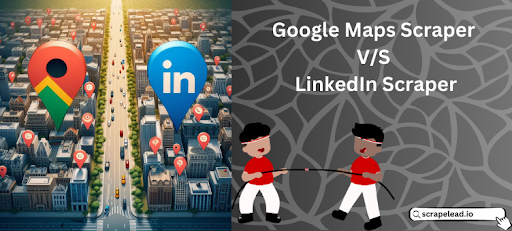
Google Maps Scraper vs. LinkedIn Scraper
B2B lead generation is all about identifying businesses that require what you have to offer. Instead of targeting individual customers, you look for businesses, collect their contact information, and reach out to convert them into paying customers. It is the backbone of business growth, connecting businesses with one another.
As a marketing pro, you’ve got two strong tools at your disposal: Google Maps Scraper and LinkedIn Scraper. Both are heavy hitters, but which one truly delivers for B2B lead generation?
“Lead generation is a fairly core activity to marketing” –Chris Brogan
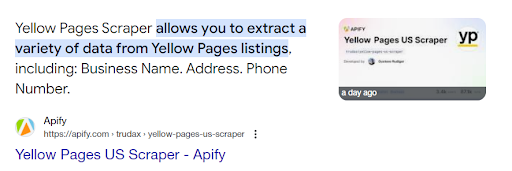
So, let’s dive in and see which tool really packs the punch!
1. Google Maps Scraper
If you’re hunting for local businesses or service providers, a Google Maps lead scraper is your golden ticket. With ScrapeLead’s Google Maps Scraper, you get all the details right from the map including business names, addresses, phone numbers, websites, and even reviews. The best part? You can target specific cities or even neighborhoods. And, it is also perfect for businesses looking to partner with companies in their local area or niche services.
Why It Rocks for B2B Lead Generation
- Spot on for grabbing info on small and medium-sized businesses. Perfect for enhancing your email marketing B2B lead generation with targeted, localized data.
- Perfect for hyper-local targeting. With a Google Maps leads scraper, you can zero in on specific cities or neighborhoods to find the ideal local partners or clients.
- No need to comb through millions of pages – it’s all in one map! Easily grab all the data you need for effective B2B email lead generation without getting lost in the weeds.
With a Google Maps leads scraper, you’ve got a powerful tool to collect detailed and precise local business data quickly.
Challenges?
Heads up!
While scraping Google Maps has its perks, it comes with risks like potential legal issues and violating terms of service, so you’ll need to be cautious if you don’t want to land in hot water. Also, Google Maps is not exactly a goldmine for deep insights. You won’t find personal details like job titles, emails, or company hierarchies. It’s great for local business searches but falls short of the full lead-gen package.
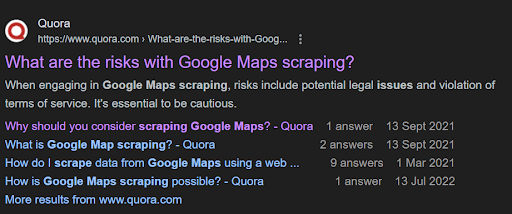
Google Maps Takes the Lead in Lead Generation
Real-Life Example
Imagine you’re a local real estate agent searching for potential commercial property leads. With ScrapeLead’s Google Maps Scraper, you can collect details on local real estate offices, giving you a solid list to reach out to with targeted offers.
2. LinkedIn Scraper
Now, if Google Maps is your local guide, LinkedIn is the master networker who knows all the big shots. ScrapeLead’s LinkedIn Scraper gives you direct access to the movers and shakers – company executives, industry experts, and decision-makers.
With Scrapelead, you’re pulling in data like job titles, skills, company size, and connections. This is the tool when you’re aiming high in B2B, targeting specific roles or industries.
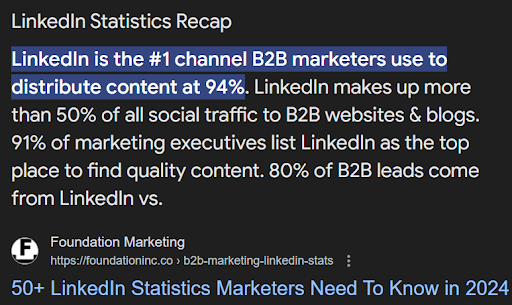
Why It’s the B2B MVP
- You’re not just getting businesses – you’re getting the right people.
- Best for finding decision-makers like CEOs, VPs, or even that one elusive marketing head you’ve been after.
- You can filter by industry, location, company size, and more.
Challenges?
LinkedIn limits how much data you can pull, especially with their privacy updates. Plus, it’s not really the place for finding small local shops, so if your leads are more on the ground than in the boardroom, you might hit a wall.
Real-Life Example
If you’re a recruiter looking for a senior marketing executive, ScrapeLead’s LinkedIn Scraper lets you find profiles that match your criteria and view their professional background, helping you target the right candidates.
So, Which Tool Wins? 🎯
Honestly, it comes down to who you’re chasing.
- Google Maps Scraper: awesome for local, small-scale B2B leads. If you’re targeting specific locations or small businesses, this is your go-to.
- LinkedIn Scraper: Ideal if you’re after corporate powerhouses or industry leaders. When you’re targeting decision-makers, LinkedIn is unbeatable.
Pro Tip: Why not use both? Start with ScrapeLead’s Google Maps scraper to get a wide net of businesses, then hop over to our LinkedIn scraper to zero in on the people you need to connect with. BOOM! You’ve got a killer lead-gen combo!
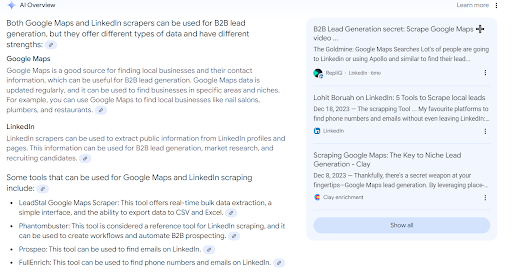
LinkedIn Scraper vs. Google Maps Scraper: The Ultimate Data Duel
If you’re ready to get into the nitty-gritty of B2B lead generation, here’s how these two data-hunting tools stack up against each other.
Data Scope: Who’s Got the Bigger Scoop? 🏆
LinkedIn Scraper
LinkedIn Scrapers are like your backstage pass to the professional world. You get to dig into profiles for names, job titles, email addresses, company info, and more. It’s a goldmine for finding the right people at companies (think decision-makers and industry influencers).
Google Maps Scraper
Google Maps Scrapers, on the other hand, are your go-to for local business intel. You scoop up data like business names, addresses, phone numbers, and websites. Great for discovering local businesses and their details, but don’t expect to find who’s who in the company or personal contact info. While these scrapers are fantastic for building out consumer email marketing lists, they won’t provide the deep dive into individual roles or personal emails.
Lead Generation: Who’s the Better Matchmaker?
LinkedIn Scraper
When it comes to lead generation, LinkedIn Scrapers are like having a VIP list for your sales and marketing campaigns. You can find potential leads, target specific roles, and get detailed insights that help you to outreach.
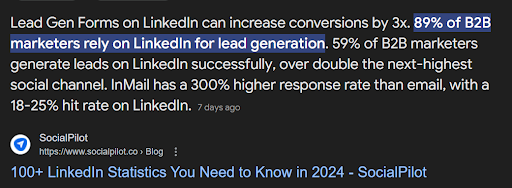
Google Maps Scraper
Google Maps Scrapers are ideal for casting a wide net, especially if you’re focusing on local leads. You get a broad list of businesses, but you might miss out on detailed contact info or specific decision-makers.
Recruitment: Who’s Got the Talent Scout Edge?
LinkedIn Scraper
Looking to recruit? LinkedIn Scrapers are your headhunting heroes. You can find profiles that match your job criteria, view detailed professional backgrounds, and even verify skills and experience.
Google Maps Scraper
Google Maps Scrapers aren’t quite built for recruitment. They’re excellent for finding local businesses, but they don’t provide deep insights into individual qualifications or roles within companies. While a free Google Maps Lead Scraper is great for collecting business details, it won’t help you with recruiting or understanding the specific roles and qualifications of individual professionals.
Market Research: Who’s the Trendspotter? 📈
LinkedIn Scraper
LinkedIn Scrapers are perfect for diving into industry trends and company data. You can analyze company sizes, industry positions, and professional networks to get a pulse on the market.
Google Maps Scrapers
It gives you a snapshot of local business presence. It’s useful for understanding local market saturation and business distribution, but lacks the deeper industry insights and trends. While a lead selling software might help you go deeper into industry trends and target specific decision-makers, a Google Maps Scraper is primarily focused on providing a broad view of local business information.
Limitations: What to Watch Out For ⚠️
LinkedIn Scraper
- Bot Behavior: Avoid scraping too many profiles too quickly – LinkedIn’s got eyes on you!
- Data Accuracy: Watch out for fake profiles and outdated info.
- Rate Limits: LinkedIn’s limits can slow down your data collection.
Google Maps Scraper
- Scope Limitations: Great for local data, but doesn’t provide detailed personal or business insights.
- Data Accuracy: Ensure the data pulled is up-to-date and relevant.
Best Practices
LinkedIn Scraper
- Stay compliant with LinkedIn’s terms of service.
- Prioritize data privacy and adhere to GDPR.
- Use reputable tools and validate data regularly.
Google Maps Scraper
When engaging in Google Maps lead generation in 5 easy steps, it’s important to:
- Follow local regulations and Google’s data use policies. Ensuring compliance with these guidelines keeps your data practices ethical and within legal boundaries.
Regularly update and verify business data accuracy. This step helps maintain the quality and relevance of your leads, ensuring that your efforts in Google Maps lead generation remain effective and current.
The Final Verdict
If you’re all about finding key players and deep dives into professional data, Scrapelead’s LinkedIn Scraper is your go-to. They’re perfect for lead generation, recruitment, and market research. Our Google Maps Scraper, however, is unbeatable for collecting local business information and getting a broad view of regional data.
FAQ
For privacy, try OpenStreetMaps, Apple Maps, or Here WeGo. For offline use, go with Sygic, Maps.me, or OsmAnd, and for live traffic info, check out Waze, ViaMichelin, or Bing Maps.
Yes, scraping publicly available data from LinkedIn is legal, but LinkedIn’s terms prohibit it. Detection may lead to account bans.
With a free LinkedIn account, you can scrape up to 80 profiles daily. If you have a premium or Sales Navigator account, the limit is up to 150 profiles per day.
Start scraping instantly
Sign up now, and get free 500 credits everymonth.
No credit card required!
Related Blog
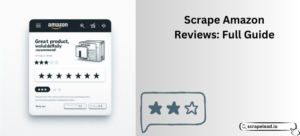
Scrape Amazon Reviews: Full Guide
Learn how to scrape Amazon reviews easily with no coding required and unlock valuable customer insights for your business.

What is the Cost of Web Scraping?
Learn how much web scraping costs, from DIY scrapers to freelancers and enterprise solutions, and find the best option for your budget.
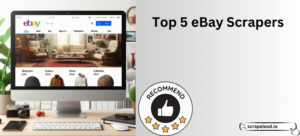
Top 5 eBay Scrapers
Explore the best eBay scrapers to gather key data, track competitors, and optimize your pricing strategy to grow your online business efficiently.

